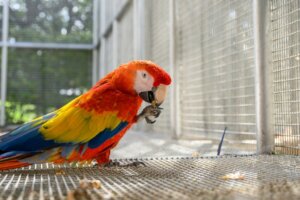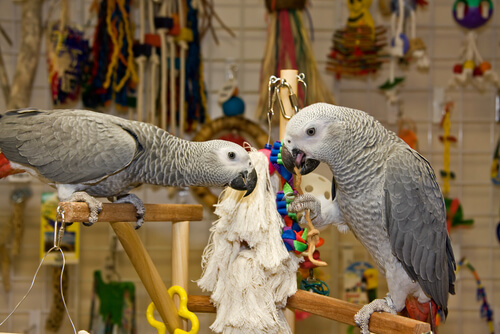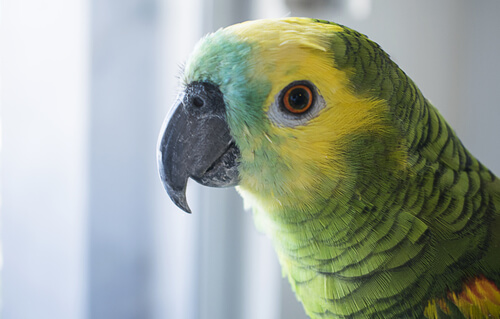How to Reduce Stress in Your Pet Parrot

Your desire to relieve stress in your pet parrot is the first step towards solving this problem. However, it can be difficult to determine the exact cause of a bird’s sadness or stress. Since these animals aren’t capable of expressing their emotional states to us through the use of words, we need to be aware of other, much more succinct signs.
For that reason, you should consider working with a veterinarian or bird trainer; they may have enough information to bring your pet relief more quickly. Here’s everything you need to know about parrot stress and how to manage it at home.
What are the most common signs of stress in your pet parrot?
Domestic parrots (family Psittacidae) are becoming increasingly common in homes. However, despite their reputation as friendly and social animals, not all keepers are aware that they require a great deal of attention, a huge facility, constant socialization, and continuous environmental enrichment. Due to the lack of care, it’s quite common for a pet parrot to develop stress.
According to professional studies, up to 11.7% of domestic psittacines damage their feathers, a clear sign of stress and emotional anxiety. Cockatiels and lovebirds seem to be most affected by this condition, but it can occur in virtually any captive bird. Some of the most obvious signs of it are as follows:
- Excessive vocalization: This can be repetitive screaming, chirping or alarm calls.
- Self-injury: Self-destruction of feathers. A stressed parrot will pluck feathers from its body, but it won’t be able to reach the feathers on its head. If the loss of feathers is generalized (also on the head), other diseases must be suspected.
- Stereotypical behavior: Such as head shaking or constant rocking from side to side. These are repetitive actions that make no sense from an ethological point of view.
- Excessive sleepiness or being withdrawn, fearful or cowering.
- Fear: The bird flees from its keeper, or hides when it used to be assertive and social.
- Aggressive behavior: Aggression towards people and other birds. Banging or biting on cage bars.
- Other signs: Hissing, panting, tail fanned, wings held away from the body or head feathers raised can also be signs of stress.
- Increased respiratory rate: This may include panting or open-mouthed breathing.
- Territorial behavior: The bird may become aggressive towards other housemates when previously it wasn’t.
Causes of stress in parrots
As you can see, anxiety conditions in psittacines are quite a bit more common than you would think at first. We’ll look at their main triggers in the following lines.
Environmental
Parrots, as the flying birds they are, are accustomed to covering long distances every day to obtain food and to reproduce. In addition, they tend to inhabit humid, rainy environments with warm temperatures. As you can imagine, living in a cage bears little resemblance to the natural conditions they thrive in.
Some of the environmental factors that can cause stress in domestic parrots are as follows:
- The cage is too small: It all depends on the species, but, ideally, the cage should be 1.5 to 2 times larger than the diameter of the bird with its wings outstretched. If this body size is 60 centimeters (about 24 inches), then the cage should be 1.20 meters (about 48 inches) wide and even higher.
- A dirty environment: Remove uneaten food every 24 hours and change the substrate every 24-28 hours. A thorough cleaning of the cage once a week is also recommended. Otherwise, the animal will become stressed by the unsanitary conditions.
- Cold temperatures: The ideal temperature for most psittacines is between 20-25°C (68 to 77 F). If it’s too cold, the animal will become ill.
- Constant changes in routine: Parrots are fixed in their habits and don’t like changes in their routines.
Physical
Stress can be both a cause and a consequence of physical discomfort in parrots. An animal that is battling a painful infection will feel constant discomfort, but anxiety can also be the cause of physiological pathology. In any case, you need to let the bird exercise outside its cage for at least 2-3 hours a day so that it can exercise its muscles and wings.
Another essential physical factor is rest. A parrot that doesn’t sleep well will show signs of stress sooner or later.
Mental factors
Psittacines are extremely intelligent animals. Therefore, as we’ve already mentioned, they require constant mental stimulation. If not, they’ll develop self-injurious behavior, stress, aggression, and many other undesirable traits. The aforementioned stereotypies represent one of the main signs of emotional anxiety in these birds.
If the parrot repeats a behavior obsessively for no reason, it’s always a very bad sign.
Social factors
Some psittacines, such as lovebirds and parakeets, are social animals, and live in monogamous pairs throughout their lives. Therefore, it’s recommended to always have a couple housed in the same facility. Something similar happens with larger species (such as the gray parrot), but you have to be careful with the size of the facility. If they aren’t given a huge space, they’ll end up attacking each other.
If your parrot lives alone in its cage, you need to interact with it for at least 2-3 hours a day. In addition, it needs to have items available within the facility to amuse themselves when you’re away.
Can you prevent stress in your pet parrot?
Although stress in your pet parrot may not be completely preventable, it’s important to pay attention to any clues your pet may give you. The key points are to avoid – as far as possible – sudden changes in lifestyle. To achieve this goal, it’s vital to know the pet’s general sensitivities before instituting changes.

Cage placement, an important issue
Ideally, a pet parrot’s cage should be placed in an area of the room that gives the bird a view of its surroundings. The location should also allow a section of the cage to be used for retreat and privacy, i.e., placed against a wall or in a corner of the room.
For extremely shy birds, one side of the cage should be partially covered with a towel or blanket, which serves to create a retreat area. Whatever the case, it’s important to avoid placing the cage in the middle of the room, on the floor, or in noisy or busy areas.
It’s also very important not to place the cage directly in front of a window, as other birds or stray mammals may frighten your parrot. Also, these places tend to be colder than other sheltered areas.
A domestic parrot needs its routines
It’s important for owners to maintain a constant routine of cleaning, feeding, and socialization. It should be noted – even though it may seem obvious – that your pet parrot’s cage should always be covered at night. As we have said earlier, a tropical parrot requires a lot of sleep (up to 12 hours) to avoid stress.
Be sure to provide a friendly treatment
It’s important to keep in mind that birds, being prey animals, are often startled by sudden movements and loud noises. For this reason, you need to approach the birds calmly and speak in soft tones. Keep the following tips in mind:
- Move slowly. If your bird is attacking you because it’s afraid or nervous, moving away quickly can agitate them even more.
- Use a stick to train them. If your pet parrot doesn’t like to be handled, but you want to help them become more sociable, offer them a stick instead of your hand. If you don’t make any progress with them, go to a professional animal behaviorist.
- Don’t scare them. Try not to stare at them or peek suddenly into their cage. Also, avoid handling your bird while wearing hats or gloves, as they may not recognize you and feel threatened.
- Other unwanted objects. Some birds are frightened by brooms or hoses, or by boxes or other unfamiliar objects moving around. Keep them away from their cage and take them out of their room when they roam free.

It’s a good idea to provide socialization and enrichment activities
Don’t neglect entertainment. Challenge your bird with stimulating toys, a TV to watch, a radio to listen to, or something exciting to keep them interested. It’s recommended to vary their toys and stimulating items each week.
Your bird may also benefit from a little extra attention if you give them more time out of their cage. During this time, they’ll be able to exercise and socialize. Of course, the area should be secure and escape-proof. The minimum time out will be 2-3 hours a day, but you can extend this as much as you like (always respecting the animal’s wishes and sleeping hours).
As flock animals, birds enjoy and are often comforted by companionship. They certainly live best in pairs. These birds shouldn’t be kept alone unless it’s for medical reasons or aggression issues. If you have only one parrot in the home, give it as much quality attention as you can each day.
All cited sources were thoroughly reviewed by our team to ensure their quality, reliability, currency, and validity. The bibliography of this article was considered reliable and of academic or scientific accuracy.
- Meehan, C. L., Garner, J. P., & Mench, J. A. (2003). Isosexual Pair Housing Improves the Welfare of Young Amazon Parrots. Applied Animal Behavior Science, 81(1), 73-88.
- Engebretson, M. (2006). The welfare and suitability of parrots as companion animals: a review. Animal welfare-potters bar then wheathampstead-, 15(3), 263.
- Ebisawa, K., Nakayama, S., Pai, C., Kinoshita, R., & Koie, H. (2021). Prevalence and risk factors for feather-damaging behavior in psittacine birds: Analysis of a Japanese nationwide survey. PloS one, 16(7), e0254610.
This text is provided for informational purposes only and does not replace consultation with a professional. If in doubt, consult your specialist.